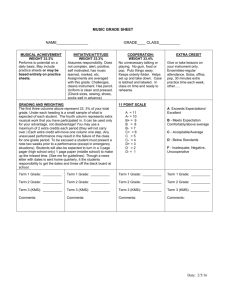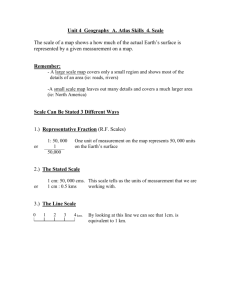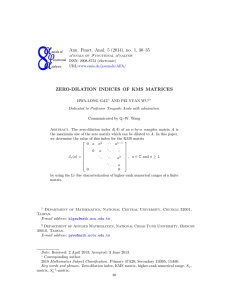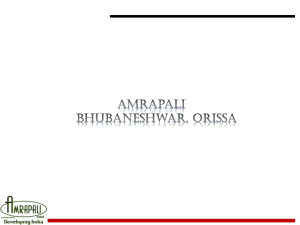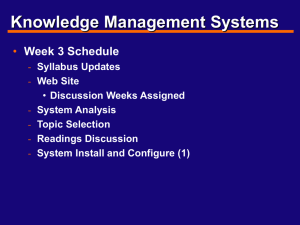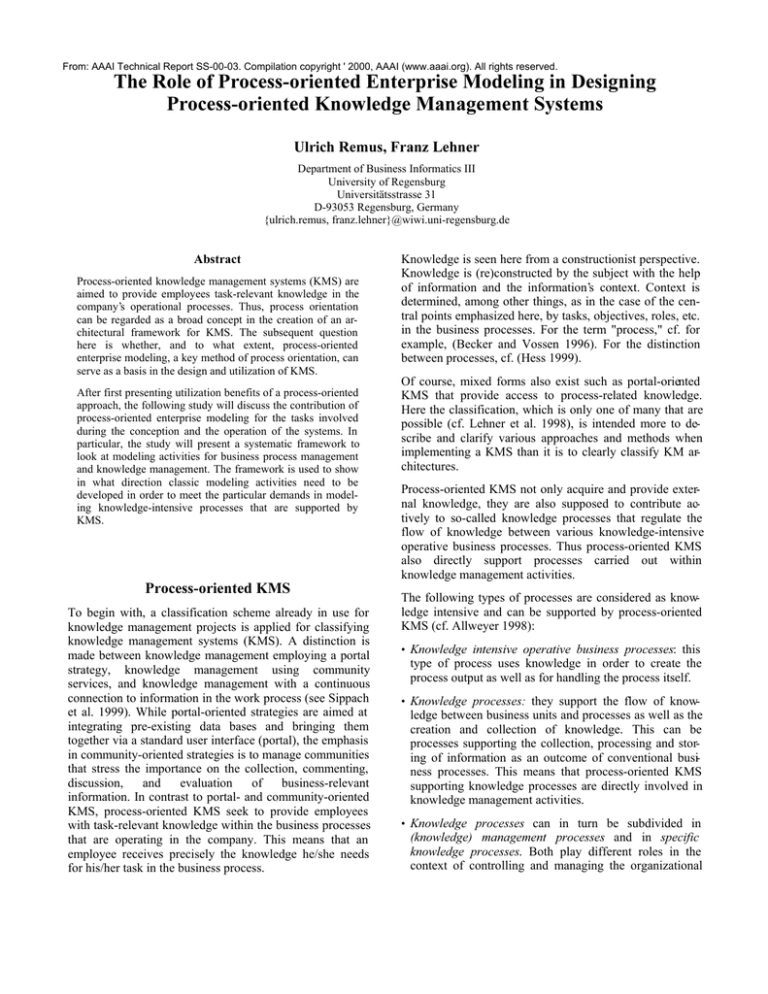
From: AAAI Technical Report SS-00-03. Compilation copyright ' 2000, AAAI (www.aaai.org). All rights reserved.
7KH5ROHRI3URFHVVRULHQWHG(QWHUSULVH0RGHOLQJLQ'HVLJQLQJ
3URFHVVRULHQWHG.QRZOHGJH0DQDJHPHQW6\VWHPV
8OULFK5HPXV)UDQ]/HKQHU
Department of Business Informatics III
University of Regensburg
Universitätsstrasse 31
D-93053 Regensburg, Germany
{ulrich.remus, franz.lehner}@wiwi.uni-regensburg.de
$EVWUDFW
Process-oriented knowledge management systems (KMS) are
aimed to provide employees task-relevant knowledge in the
company’s operational processes. Thus, process orientation
can be regarded as a broad concept in the creation of an architectural framework for KMS. The subsequent question
here is whether, and to what extent, process-oriented
enterprise modeling, a key method of process orientation, can
serve as a basis in the design and utilization of KMS.
After first presenting utilization benefits of a process-oriented
approach, the following study will discuss the contribution of
process-oriented enterprise modeling for the tasks involved
during the conception and the operation of the systems. In
particular, the study will present a systematic framework to
look at modeling activities for business process management
and knowledge management. The framework is used to show
in what direction classic modeling activities need to be
developed in order to meet the particular demands in modeling knowledge-intensive processes that are supported by
KMS.
3URFHVVRULHQWHG.06
To begin with, a classification scheme already in use for
knowledge management projects is applied for classifying
knowledge management systems (KMS). A distinction is
made between knowledge management employing a portal
strategy, knowledge management using community
services, and knowledge management with a continuous
connection to information in the work process (see Sippach
et al. 1999). While portal-oriented strategies are aimed at
integrating pre-existing data bases and bringing them
together via a standard user interface (portal), the emphasis
in community-oriented strategies is to manage communities
that stress the importance on the collection, commenting,
discussion,
and
evaluation
of
business-relevant
information. In contrast to portal- and community-oriented
KMS, process-oriented KMS seek to provide employees
with task-relevant knowledge within the business processes
that are operating in the company. This means that an
employee receives precisely the knowledge he/she needs
for his/her task in the business process.
Knowledge is seen here from a constructionist perspective.
Knowledge is (re)constructed by the subject with the help
of information and the information’s context. Context is
determined, among other things, as in the case of the central points emphasized here, by tasks, objectives, roles, etc.
in the business processes. For the term "process," cf. for
example, (Becker and Vossen 1996). For the distinction
between processes, cf. (Hess 1999).
Of course, mixed forms also exist such as portal-oriented
KMS that provide access to process-related knowledge.
Here the classification, which is only one of many that are
possible (cf. Lehner et al. 1998), is intended more to describe and clarify various approaches and methods when
implementing a KMS than it is to clearly classify KM architectures.
Process-oriented KMS not only acquire and provide external knowledge, they are also supposed to contribute actively to so-called knowledge processes that regulate the
flow of knowledge between various knowledge-intensive
operative business processes. Thus process-oriented KMS
also directly support processes carried out within
knowledge management activities.
The following types of processes are considered as knowledge intensive and can be supported by process-oriented
KMS (cf. Allweyer 1998):
ù .QRZOHGJH LQWHQVLYH RSHUDWLYH EXVLQHVV SURFHVVHV: this
type of process uses knowledge in order to create the
process output as well as for handling the process itself.
ù .QRZOHGJH SURFHVVHV they support the flow of know-
ledge between business units and processes as well as the
creation and collection of knowledge. This can be
processes supporting the collection, processing and storing of information as an outcome of conventional business processes. This means that process-oriented KMS
supporting knowledge processes are directly involved in
knowledge management activities.
ù .QRZOHGJH SURFHVVHV can in turn be subdivided in
NQRZOHGJH PDQDJHPHQW SURFHVVHV and in VSHFLILF
NQRZOHGJH SURFHVVHV. Both play different roles in the
context of controlling and managing the organizational
knowledge base. This differentiation is based on a distinction made by Probst, who mentioned two principles
important for the arrangement of the components within
his knowledge life cycle. The external cycle consists of
goal settings, implementations and measuring knowledge. It builds on the traditional management process.
An internal cycle of specific knowledge processes like
knowledge identification, knowledge presentation and
knowledge distribution links these processes and defines
a relation between them (cf. Probst et al. 1998).
Typically, the main component to guide process-oriented
KMS is a navigation structure derived from process
descriptions. This structure links process elements, for
example process parts, tasks, roles, information- or business-objects or process outputs, to various knowledge
elements. These can be links to documents concerned with
project descriptions, with lessons learned, or with task instructions, or they can provide access to other knowledge
systems such as expert systems, business intelligence
solutions, or research data bases. Links to communication
channels such as e-mail or news forums also allow for
direct contact to knowledge sources and groups (cf. fig. 1).
knowledge items
knowledge intensive processes during run-time.
Thus, process-oriented KMS identify, filter, manage, and
organize process-relevant knowledge in order to provide it
in the processes.
At first glance these systems seem to be no more than
document or content management systems with some intelligent functions added. This is not quite true because
there are some attributes qualifying them as KMS. First of
all they realize and document specific knowledge processes
(e.g. processes for identification, collection, distribution,
sharing and storing of knowledge and processes for
managing and improving the structure and content of the
knowledge base). Secondly there is a link between the
components of a business process (role, activity, resource)
and process-related knowledge items. And last but not least
the use of KMS stimulates process orientation and thus
supports
continuous
process
improvement
and
organizational learning.
In the following, we show the advantages of a processoriented approach for KMS before we proceed to the central point, the contribution of process modeling to system
design.
3RWHQWLDOVDQG%HQHILWVRID
3URFHVVRULHQWHG$SSURDFK
files/ db
documents
group
supported
systems
access to
information
systems
http://www/
.QRZOHGJHLQWHQVLYHSURFHVVHV
Email
lin
ù 9DOXH
k
business
intelligence
solutions
knowledge
broker
multi media
Experts
Fig. 1: Process-oriented navigation in knowledge sources.
The immediate support of processes by IT-solutions controlling the workflow in a narrow sense has not been
described in this figure. Systems like intelligent workflow
applications or groupware systems can provide real-time
information about the actual context of a process (cf. e.g.
Reimer et al. 1998, Wargitsch et al. 1998). This means that
they contribute in many ways to process-oriented KMS.
A successful improvement of knowledge intensive
processes has a stronger relationship to the flow of knowledge and information than to the workflow (cf. Davenport
et al. 1996). This means that existing knowledge which is
not generally available or accessible within business
processes may be of great importance. As a consequence
process-oriented KMS should also focus on the design and
maintenance of the organizational knowledge base and the
connected flows of knowledge in order to link them to
FKDLQ RULHQWDWLRQ The process orientation
corresponds to the value chain. Knowledge that contributes to value added activities is successfully linked to the
business process. Thus, knowledge can be offered to an
employee in a much more targeted way. At the same
time, however, an information overload can be avoided,
since only information relevant to the value added activity is filtered and made available. Additionally knowledge management activities directly support selected
knowledge intensive processes. The process view is an
important and integrative factor.
ù &RQWH[W UHOHYDQFH The second benefit of process-
orientation is that processes can provide part of the context that is important for the interpretation and construction of process-relevant knowledge. Especially
knowledge that emerges or is created in a process should
be stored together with its process context. That includes
knowledge about processes that is to be stored together
with the process of creation and use. Here, the broadness
of the process context can be variably defined. It
stretches from information on individual activities and
partial processes to information about connections extending over more than one process and needs to be linkable to the information required by a particular person or
specific role. This is important because every employee
possesses a different level of prior context knowledge
and therefore needs a certain amount of extra context
information.
ù ,PSURYHPHQW LQ NQRZOHGJH SURFHVVLQJ Next to the ad-
vantages resulting from a company’s analysis of its own
business processes, such as making tasks clearer and
promoting an integrative view, this can also be the starting point for a more targeted improvement in the
processing of knowledge in these activities. Thus both the
knowledge used in the processes and the knowledge
about processes become clearer and more transparent.
Knowledge about processes thereby becomes an integral
part of a company’s knowledge base.
ù 6XSSRUW IRU SURFHVVRULHQWHG NQRZOHGJH PDQDJHPHQW
Knowledge management is included in process-oriented
considerations. Processes such as management processes
that guide and monitor the flow of information, or even
specific knowledge processes responsible for the exchange of information between processes, can be
implemented and established organizationally (for
example, by creating a position as process owner). An
example for a typical knowledge process would be a
publishing process in the corporate intranet. Different
roles (e.g. responsibility for a topic, author, webmaster)
and tasks are combined to a specific and integrated
process. The design of knowledge processes like this can
be supported by systematic modeling activities. A big
problem in knowledge management is also the
transparency about costs and benefits. Practicable
approaches to knowledge controlling could profit from a
process-oriented approach.
ù 1DYLJDWLRQ DQG GHVLJQ FRPSRQHQWV RI .06 In the de-
sign of KMS, processes can be the starting point for the
conception of a navigation structure that, next to general
retrieval possibilities, navigation within categories
(subjects that are process-related or span more than one
process) (cf. Bach et al. 1999), also permit navigation
that follows processes as they run. Other information
from processes can also be used to specify KMS more
precisely. In addition to the aforementioned navigation
structure, process-oriented knowledge maps and knowledge structure diagrams can be broadly sketched out.
7KH5ROHRI3URFHVVRULHQWHG
(QWHUSULVH0RGHOLQJ
In order to link activities in business processes to the
knowledge necessary to carry them out, the precise understanding of these processes is required. As a method for
knowledge explication business process modeling (BPM)
provides models that may be employed in a variety of ways
in the design of KMS.
The definition for process modeling preferred in this study
not only focuses processes in the narrow sense of the term
(i.e., control flow), but rather broadens it to include
business resp. enterprise modeling, which includes other
perspectives, such as data, functions, organizations,
resources, strategies, and knowledge. Despite this we
continue to use the term business process modeling even if
the term process-oriented enterprise modeling would be the
more correct one. One reason is the integrative function of
business process models for different types of enterprise
models. The other reason is that process models are useful
instruments to visualize the value chain and therefore build
a framework to support knowledge management activities.
In the following we will discuss the tasks of BPM during
build and run time of a process-oriented KMS.
,QWKH'HVLJQ3KDVH
ù 1DYLJDWLRQ Process models can be integrated as central
navigation structures within a KMS so that the assignment of knowledge to individual activities is made clear
and employees receive the knowledge they require. Some
commercial KMS already incorporate such a structure.
ù &RQWH[W The idea behind is that information about the
process provides part of the context information for the
(re)construction of knowledge. This context information
can refer to the sequence of process steps (process
control), single components or goals. If the context
information is stored together with the information itself
it is easier to reconstruct details later. Process models
allow the analysis which leads to the detection of
knowledge resources that might be key candidates for
capturing additional context information. An example
might be a decision to be made in a publishing company
about the acceptance of a manuscript. The whole process
leading to the final decision will be documented. The
relevant information can be captured real-time either by
intelligent systems or by the use of checklists. The
necessity of capturing context information in the case of a
decision can already be seen in advance when modeling
the checklists or the supporting IS. An example for such
context information could be known profile information
about the employees involved in the decision.
ù 9LVXDOL]DWLRQ such context information could also be
expanded to include other elements such as multimedia
elements, visualization techniques or additional models.
However too much context may be counterproductive (cf.
Buckingham Shum 1998).
ù 3URFHVV NQRZOHGJH In addition, process models can be
used to gather knowledge relevant to a process. With a
process description an employee can analyze in an easier
way what his knowledge needs and deficits are. Logically
these information can be used to define and derive broad
outlines of knowledge maps. Knowledge maps, however,
are only useful if they are up to date. Therefore, a model
of this information has to be expanded to include a
dynamic component to update model knowledge.
A typical example is the administration of employee
profiles. First, a number of base profiles are centrally
stored. Employees themselves can then start new profiles,
categorize and arrange them. The result is a highly
dynamic profile administration system that updates itself,
which would not be possible using static modeling
methods.
ù .QRZOHGJH 3URFHVVHV On the basis of such an analysis,
optimization measures along the lines of "Knowledge
Process Reengineering" can be carried out more easily.
Note that the concentration on knowledge intensive
processes should mainly focus on the flow of knowledge
instead of the workflow. Most business or information
models neglect this demand (cf. Kock et al. 1997, Stader
and Jarvis 1998). Furthermore knowledge flows are not
only restricted to one process and can only be captured
by special modeling techniques like knowledge flow
analysis or communication analysis.
ù 3XVK 3XOO In course of the design of a knowledge
process it has to be defined whether the knowledge will
be distributed by a push- or a pull-strategy. Processoriented KMS do not necessarily employ only pull
strategies. Actually, a mix of push and pull strategies can
help to keep process knowledge up to date and to supply
employees in the processes with current information. For
example, an employee who serves customers as a key
account manager receives regularly information filtered
according to his task from external information sources
(push). In addition, out of the context of his assignment,
he is offered proven search paths that he may use for
possible searches (pull). Further research is necessary to
get evidence which information about a process or part of
a process, certain types of activities, events or roles is
needed for push / pull design decisions.
ù :RUNIORZ PRGHOLQJ The analysis of process models can
be a first step towards the definition of workflow models.
During run time these models manage the workflow of
knowledge intensive processes.
Some of these aspects are currently investigated at a semiconductor producer. Existing process models based on ISO
9001 are used to document the formation and use of knowledge of a product development process. Interviews with
the people engaged in the process are carried out to gain
this knowledge. The interviews result in role specific information and knowledge profiles which can be used for
knowledge maps and knowledge diagrams. In a second step
the results of an information and knowledge flow analysis
contribute to the design of specific knowledge processes.
This includes a modeling phase succeeded by the
realization of this process which means defining personal
responsibilities and supporting the actual process by information technologies (e.g. publishing or content
management systems). Simultaneously new sources of
knowledge are identified in order to meet the demands of
the product development process. Among others an OLTPand a data mining solution is about to be developed to
visualize standard figures describing the quality of certain
activities.
,QWKH2SHUDWLRQ3KDVH
ù &RQWLQXRXV SURFHVV LPSURYHPHQW &3, It can be
assumed that the use of process models as navigation
components leads to a better understanding of both one’s
own as well as other processes. As a result, weak spots
can be found in a process. With a CPI, these weak spots
can be analyzed and corrected. Since process models
themselves embody knowledge, this process knowledge
also has to be kept updated. Implementation of a CPI is
one way to accomplish this.
ù 5XQWLPH PRGHOLQJ Components of KMS themselves can
contribute to the support of modeling activities. Here,
KM-functions are used for dynamic modeling and for
completion and updating of process knowledge. Process
knowledge includes knowledge intensive workflows,
knowledge maps, profiles, etc. The small control loop
constructed between the modeling and the KMS serves as
a dynamic system component that keeps the models
updated.
ù &RQWH[W XSGDWH The relevance of process models in de-
termining context has already been indicated. During the
run time, the context information may have to be updated
and expanded to include other elements (e.g., multimedia
elements). Processes that are typically modeled on type
level have to be updated during the run time with current
process information in order to determine the context
more precisely on the basis of current process data.
In all of the cases described above, the acquisition and
documentation (modeling) of processes can be useful.
However, there are difficulties and problems that should
not be overlooked.
ù 7KH LGHQWLILFDWLRQ DQG VHSDUDWLRQ RI SURFHVVHV The iden-
tification and separation of business processes often
causes problems. Therefore, what must be investigated is
which characteristics can help identify and distinguish
knowledge-intensive processes? (see Eppler et al. 1999)
Currently one of the authors works on this topic and tries
to identify the main characteristics of knowledge
intensive processes and put them down in a checklist.
This checklist is intended to support the systematic
analysis of a process and to serve as a starting point for
„knowledge process reengineering“ activities.
ù :HDNO\ VWUXFWXUHG SURFHVVHV Knowledge-intensive busi-
ness processes are often poorly structured and are therefore at first difficult to model. Which modeling techniques can nevertheless be used to understand the
processes? What are the limitations of modeling in this
case? Several research institutes are working in this field.
They try to use AI technologies for modeling and implement the result in workflow applications in order to support flexibility and organizational learning (see e.g.
Reimer et al. 1998, Wargitsch 1998).
ù 3URFHVV NQRZOHGJH Process knowledge lies in the hands
of the employees themselves and is difficult to be
collected and maintained centrally. What methods or
actions can be employed to ascertain this knowledge?
Another difficulty arises from the fact that process knowledge is constantly changing and yet needs to be current.
What methods can be used to keep process knowledge up
to date?
provement). Due to the fact that many knowledgeintensive processes cannot be determined, a dynamic
run-time modeling phase must be added. Build and run
time thereby coincide. Methods to support this are
incomplete modeling and late modeling.
ù 0RGHOLQJDFWLRQ The classic business process models are
often carried out centrally with the help of modeling
experts. Yet, these experts usually do not possess the
process knowledge of the functional departments.
However, especially the individual employee’s implicit
knowledge about the many "little" processes, methods,
and best practices should be documented and also made
available to other employees (cf. Geib and Wagner
1997). Due to the individual aspect of the resource
knowledge, it seems reasonable to introduce more
decentralized or participatory modeling activities.
This brief outline of the problems associated with modeling
knowledge-intensive processes shows that classic business
process modeling methods alone are not enough to give the
"knowledge" factor in business process models the
necessary consideration when designing KMS. For this
reason we will now present a framework where different
BPM and KM modeling methods and procedures can be
classified that can lead to a meaningful expansion of
modeling activities.
Note that the characteristics of modeling time,
action and scope are
strongly dependent on the
modeling objectives. Consistent and valid requirements for IT solutions,
like the specification of a
KMS, require modeling
methods that are different
from those that are needed
to promote understanding
and
new
knowledge
within the business (see
fig. 2).
modeling
objectives
modeling
time
modeling
action
employee
oriented
modeling
decentral
Fig. 3: The shift of modeling activities when using BPM for
knowledge-intensive processes.
ù
0RGHOLQJ VFRSH In the future, modeling also has to be
able to capture and represent knowledge. For this purpose, the business process model has to be expanded to
include methods for mapping and modeling knowledge.
Here, it needs to be clarified to what extent methods
from the field of artificial intelligence could be useful.
Suggestions have already been made in the literature for
recording process knowledge for knowledge
management, for example, by producing knowledge
maps (cf. Hagemeyer and Rolles 1998). Of course,
these are rather static approaches. On the level of flows
the recording and understanding of workflows is not
enough. It has to be supported by the analysis of data-,
information- and knowledge flows. Certainly the
process view should be used for integration. The main
purpose is not to loose the advantages of process orientation.
ù
0RGHOLQJ PHWKRGV In order to fulfill the requirements
with regard to modeling time, action and scope, classic
methods for BPM have to be expanded to include the
following methods: new model and object types
expand classic approaches to include elements in
knowledge processing (see Allweyer 1998). Workplace
modeling
support
Fig. 2: modeling dependencies
model. In the case of classic business process models,
modeling is done first. At best, a dynamic component
comes into play in a CPI (continuous process im-
extended
7UDGLWLRQDO process
modeling
%30
Modeling action
modeling
methods
ù 0RGHOLQJ WLPH The modeling time indicates when to
NQRZOHGJH participLQWHQVLYH
atory
SURFHVVHV modeling
central
modeling
scope
In particular, the following aspects in modeling are to be
considered.
kn
late Modeling C mo owl
om del edg
virtual reality
in e
g
m mu
od ni
el ca
in tio
%30IRU
g n
multi media
visualization
5XQ7LPH
%XLOG7LPH
In order to put the expansions in a certain order, it is suggested to classify them, on the one hand, into the two
dimensions, modeling time and modeling action and, on the
other hand, into modeling scope, modeling methods, and
modeling support. Fig. 3 shows modeling methods
arranged in a matrix determined by the two dimensions,
time and action. The modeling scope is visualized by the
area of a circle. The figure attempts to show that, in order
to consider the resource "knowledge," modeling increases
in scope. As a result, classic modeling methods have to be
expanded to include new concepts that in turn create new
demands on support.
static
7KH([SDQVLRQRI0RGHOLQJ$FWLYLWLHV
dynamic
time of
modeling
ù
or employee-oriented modeling methods (see Jarke and
Kethers 1998) try to reproduce the knowledge or
knowledge processes that the individual employee sees
and uses at work each day. Methods and concepts for
interactive modeling using multimedia elements, virtual
reality, and visualization techniques will play a larger
role in modeling business processes in the future (cf.
e.g. IMPROVE 1999). The consideration of knowledge
flows by modeling techniques seems to be most important. This can be done by information flow- or communication models because they create transparency
about the flow of knowledge within and outside of
business processes.
adaptive components. For the concept development of a
process-oriented KMS the corporate knowledge base and
the knowledge flows play the main role. Process models
extended by knowledge aspects should be supported by
information flow and communication models.
0RGHOLQJ VXSSRUW Modeling needs to be supported by
tools. Especially the new methods discussed above need
to be adequately considered. The subject of reuse
(process modules, process patterns, and reference
models)1 can also be useful when designing models.
In order to present more detailed results and experiences
with the modeling of process-oriented KMS further studies
will be necessary. Next step of the ongoing research
activities will be to use the modeling framework presented
here to refine the modeling activities for different types of
KMS.
6XPPDU\DQG2XWORRN
In this article, process-oriented KMS were singled out and
presented as a particular class of KMS whose features
justify their classification as "process-oriented." The
special role of processes, both as "context suppliers" as
well as navigation and design components for KMS, should
be emphasized here once more. Process-oriented enterprise
modeling was looked at in detail as a method for collecting
information for processes and modeling these processes
because it can be regarded as a central starting point for the
design and utilization of KMS.
Of course, instruments for information- and knowledge
modeling are without any use if the objective and the
application field remain unclear. Depending on the
objectives alternative methods and techniques can be taken
into consideration. Possible areas of application of
knowledge management are among others the improvement
and design of knowledge intensive processes and the
development of KMS.
For the optimization of processes a rough process overview
may be sufficient. In the case of designing a KMS, a very
detailed description of the processes is necessary.
Nevertheless in the latter case a lot of questions remain
unanswered. Should, for instance, process control be
automated by an intelligent workflow concept? In that case
the resulting models have to be extended by dynamic and
1
3URFHVV PRGXOHV are partial processes that can be reused for other
processes. Here, the internal view of the process is transparent. Only
the interfaces to other partial processes are externally visible. The
SDWWHUQ concept is based on the fact that application elements are
frequently connected to one another in a similar fashion. These
constantly recurring patterns can also be used for processes.
5HIHUHQFH PRGHOV, which describe processes or even partial processes
on various levels, can be used as reference for modeling the same
kinds of processes or partial processes, thereby greatly simplifying
the modeling and guaranteeing quality.
However, the classical methods, techniques, and approaches to BPM for modeling knowledge-intensive
processes are not sufficient and have to be expanded to include new aspects. Here, it can generally be observed that
modeling activities for knowledge-intensive processes
move from a central, static approach to a broader, more decentralized and dynamic one.
%LEOLRJUDSK\
Allweyer, T.: Modellbasiertes Wissensmanagement, in Information Management, No.1, 1998, 37-45.
Bach, V.; Vogler, P.; Österle, H.: Business-KnowledgeManagement: Praxiserfahrungen mit intranet-basierten
Lösungen, Berlin, 1999, 52.
Becker, J.; Vossen, G.: Geschäftsprozeßmodellierung und
Workflow-Management, Bonn 1996, 18.
Buckingham Shum, S.: Negotiating the Construction of
Organizational Memories, in Information Technology for
Knowledge Management. Borghoff, U. M. and Pareschi,
R., (Eds.), Berlin, 1998, 55-78.
Davenport, T.H.; Jarvenpaa, S.L.; Beers, M.C.: Improving
Knowledge Work, in: Sloan Management Review, Summer 1996, 53-63.
Eppler, M; Seifried, P; Röpnack, A.: Improving Knowledge Intensive Processes through an Enterprise Knowledge Medium, in: Proceedings of the 1999 ACM SIGPR
CONFERENCE, New Orleans, 01/99.
Geib, T.; Wagner, K.: Neue Wege der Geschäftsprozeßgestaltung, in: Information Management & Consulting 12
(1997), special edition, 79-82.
Hagemeyer, J.; Rolles, R.: Erhebung von Prozeßwissen für
das Wissensmanagement, in Information Management &
Consulting 13 (1998), 46-50.
Hess, T.: Abgrenzung von Geschäftsprozessen, in HMD Praxis der Wirtschaftsinformatik, No. 207, 7/99, 95- 102.
IMPROVE: Interactive Modeling of Business Processes in
Virtual Environments, Institut für Wirtschaftsinformatik,
Universität
des
Saarlandes,
http://www.iwi.unisb.de/improve/, last access: 27.5.99.
Jarke, M.; Kethers, S.: Regionale Kooperationskompetenz:
Probleme und Modellierungstechniken, in: Wirtschaftsinformatik 4/99, 316-325.
Kock, N.F.,Jr.; McQueen, R.J.;Corner, J.L.: The Nature of
Data, Information and Knowledge Exchanges in Business
Processes: Implications for Process Improvement and
Organizational Learning, in: The Learning Organization,
V.4, No. 2, Bradford 1997, 70-80.
Lehner, F.; Maier, R.; Klosa, O.: Organizational Memory
Systems - Application of Advanced Database & Network
Technologies in Organizations. In: Reimer, U. (ed.):
Practical Aspects of Knowledge Management. Proceedings of the Second International Conference PAKM98,
Basel, 29-30 October, 1998, 14-1 - 14-12.
Probst, G.; Raub, S.; Romhard, K.: Wissen managen : wie
Unternehmen ihre wertvollste Ressource optimal nutzen ,
Frankfurt 1998.
Reimer, U.; Margelisch A.; Novotny B.; Vetterli T.:
EULE2: A Knowledge-Based System for Supporting Office Work, In: ACM SIGGROUP Bulletin, Vol.19, No.1,
1998, 56-61.
Sippach, K.;Niemeier, J; Vuong,T.A.: Aktuelle Softwarelösungen im Bereich Wissensmanagement der
Multimedia Software GmbH Dresden, in HMD - Praxis
der Wirtschaftsinformatik, No. 208, 8/99, 62-65.
Stader, J.; Jarvis, P.: Intelligent Support for Enterprise
Modeling, Technical Report, University of Edingburgh,
1998, 3.
Wargitsch, C.; Wewers, T.; Theisinger, F.: An Organizational-Memory-Based Approach for an Evolutionary
Workflow Management System - Concepts and Implementation, in: Nunamaker, J. R. (ed.), Proceedings of the
31st Annual Hawaii International Conference on System
Sciences, Vol. I, Los Alamitos (Hawaii) 1998, 174-183.

